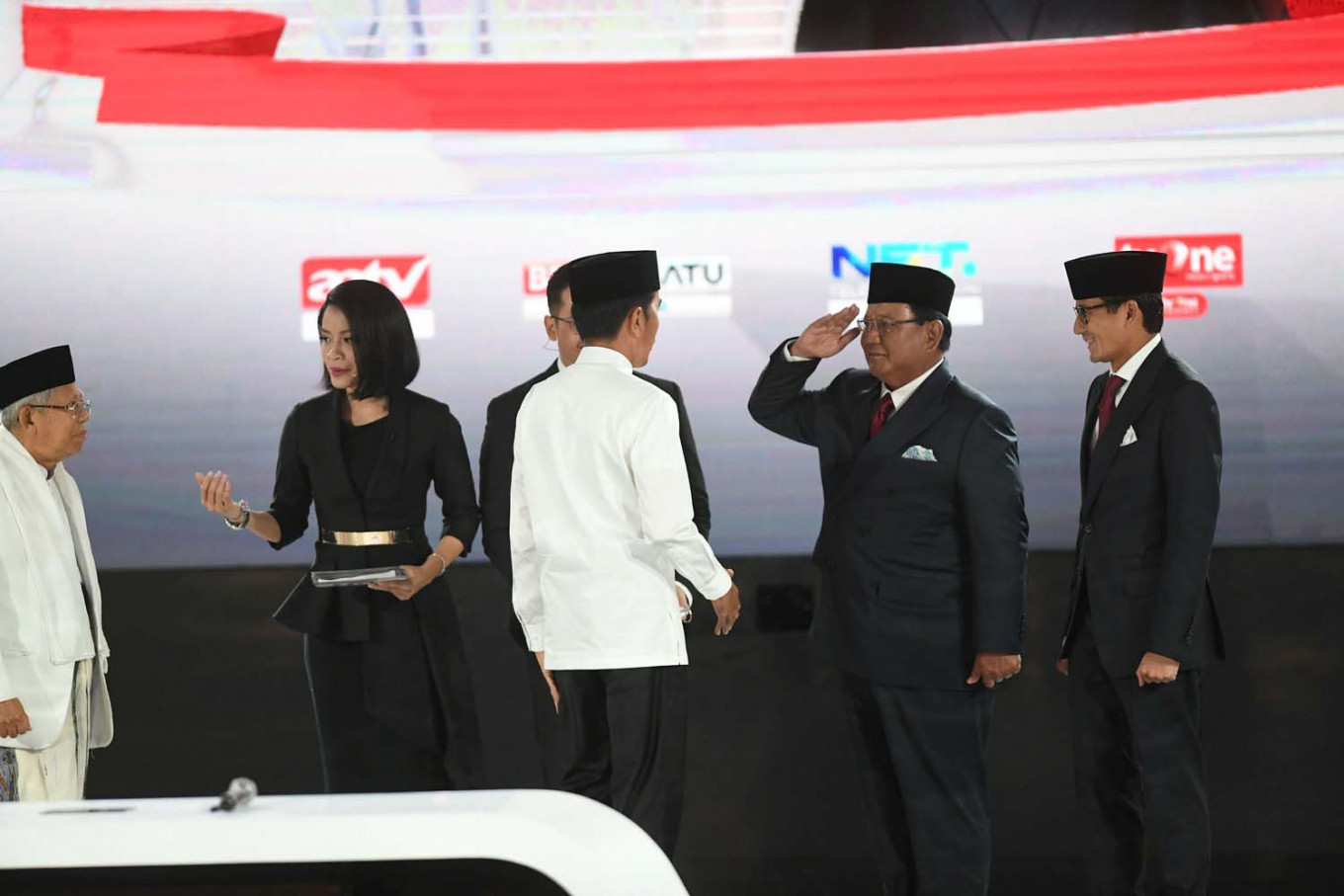Experts, House factions suggest lower presidential nomination threshold
House of Representatives factions are divided over the issue of the presidential nomination threshold as they deliberate a revision of the Elections Law.
Change Size
 The presidential candidate pair of Joko "Jokowi" Widodo (second left) and Ma’ruf Amin (left) greets the opposition pair of Prabowo Subianto (second right) and Sandiaga Uno (right) before the fifth debate prior to the 2019 presidential election at Sultan Hotel in Jakarta on April 13, 2019. (Antara/Wahyu Putro A)
The presidential candidate pair of Joko "Jokowi" Widodo (second left) and Ma’ruf Amin (left) greets the opposition pair of Prabowo Subianto (second right) and Sandiaga Uno (right) before the fifth debate prior to the 2019 presidential election at Sultan Hotel in Jakarta on April 13, 2019. (Antara/Wahyu Putro A)
S
everal factions at the House of Representatives as well as political experts have suggested lowering or eliminating the vote threshold for political parties to nominate presidential candidates.
Article 222 of the 2017 Elections Law states that a political party or coalition of parties must have secured at least 20 percent of the seats at the House of Representatives or 25 percent of the popular vote in the 2014 elections to nominate a presidential candidate in the 2019 elections.
The same type of provision has been included in a draft dated May 6 to revise the Elections Law in preparation for the next elections.
The draft was prepared by House Commission II, which oversees home affairs, and the House Expertise Board.
During a hearing by the commission on Wednesday, some experts recommended a reduction of the threshold to facilitate more presidential candidates.
Political expert Valina Singka Subekti of the University of Indonesia questioned the draft for maintaining the threshold. She suggested that the House eliminate it altogether, as the Constitution only mandated that political parties endorse presidential and vice-presidential candidates, with no mention of a threshold.
“Indonesia has a presidential nomination threshold while many other democratic countries do not,” she said.
The presidential nomination threshold in Indonesia was introduced in 2004, when the figure was set at 15 percent, equal to 20 percent of House seats. Five years later, the House raised the bar to 20 percent of the seats or 25 percent of the popular vote.
Valina said the 2004 presidential election was the ideal presidential election, with five candidate pairs running: Wiranto-Salahuddin Wahid, Megawati Sukarnoputri-Hasyim Muzadi, Amien Rais-Siswono Yudo Husodo, Susilo Bambang Yudhoyono-Jusuf Kalla and Hamzah Haz-Agum Gumelar.
"We have experienced a presidential election in which many pairs were participating. This is nothing new. At that time, the political parties and constituents were happy, as they could channel their aspirations and promote their best candidates,” she said.
Centre for Strategic and International Studies (CSIS) executive director Philips J. Vermonte echoed Valina’s concern, calling on the House to reduce the threshold.
He went on to say that a higher threshold had resulted in polarization among the people, as seen in the presidential elections of 2014 and 2019. A survey found that Indonesians became more polarized than ever based on their preferred presidential candidates as they only had two candidate pairs.
Philips suggested that the election should have "at least three or four candidate pairs.”
Parties in the government coalition are divided over the threshold, with the NasDem Party, the National Awakening Party (PKB) and the United Development Party (PPP) suggesting a lower threshold. They are the three parties that garnered lower shares of the popular vote than the other members of the coalition in the 2019 election.
“We’re sure that we will have two pairs running head to head again if it’s 20 percent. If it’s 15 percent, four to five [candidate pairs] may participate. More pairs means more options for the people,” NasDem House faction chairman Ahmad Ali said.
On the other hand, the ruling Indonesian Democratic Party of Struggle (PDI-P) and the Golkar Party, which were in the first and third position in last year’s election, endorsed the same threshold. Meanwhile, the runner-up in the 2019 election, the Gerindra Party, remained undecided.
Three parties outside the ruling coalition expected the threshold to be between 10 and 15 percent. The Prosperous Justice Party (PKS) proposed a lower threshold, although it later stated that it was fine with keeping the current threshold.
PKS House faction chairman Jazuli Juwaini said a lower threshold could allow for greater diversity of ideas during the presidential election. “We hope there are at least three pairs, [so there will be] no polarization, like in the 2019 election.”
Commission II chairman Ahmad Doli Kurnia said the draft was still very much open for change, because factions were still divided over it. He went on to say that the draft, including the provision on the presidential nomination threshold, might change to accommodate several opinions.
“The experts' opinion will also be one of our considerations in formulating the bill,” he said.









